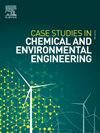地球物理学在垃圾渗滤液污染物羽流的环境评估、监测和管理中的发展作用:综述
Q1 Environmental Science
Case Studies in Chemical and Environmental Engineering
Pub Date : 2025-01-31
DOI:10.1016/j.cscee.2025.101124
引用次数: 0
摘要
垃圾填埋场渗滤液是一种有毒的污染物,对水资源、生态系统和公众健康构成了无声的威胁。传统的监测方法难以掌握这种危险的全部程度,使我们对污染的阴险蔓延视而不见。这篇综述强调了地球物理学作为一种强大的工具的重要作用,它可以窥探地表以下,揭开llp的神秘面纱,以应对这些挑战,展示了地球物理学以前所未有的细节探测、绘制、表征和监测llp的能力。该研究考察了地球物理方法的有效性,如电阻率、地震、电磁(EM)和磁,增强了它们的优势和局限性。电阻率成像(ERI)和探地雷达(GPR)在评估和监测LLP污染物羽流方面表现出较高的强度,地震折射层析成像(SRT)和地磁测量(GMS)表现出中等强度,甚低频电磁(VLF-EM)技术在探测和绘制不相交的地下污染物羽流方面存在不足。不同地球物理方法的比较研究表明,llp通常表现出比宿主环境更高或更低的地球物理特性(密度、磁性或电导率),这使得地球物理工具能够以快速、低成本、高精度和高分辨率的方式检测和绘制llp,而不会对地表/地下进行入侵和二次污染入侵。尽管地球物理技术在了解地下llp的行为方面做出了重大贡献,但它可能无法完全取代直接调查,如地质钻孔数据和地球化学水分析,以充分监测环境。然而,一些关键的影响因素,如地下孔隙度、水力导电性、氧化还原条件、非均质污染物、地质性质、水土含量和地下水流动动力学,似乎对地球物理数据采集有重大影响,可能会预测出假阳性/阴性结果。案例研究展示了地球物理学在增强对llp的理解、指导可持续废物管理实践方面的地位和作用。总之,地球物理为LLP管理提供了一种无创、经济、高分辨率的方法。未来的研究应侧重于开发先进的数据解释技术,将地球物理数据与其他环境监测数据相结合,并探索使用人工智能对LLP行为进行自动分析和预测,最终帮助环境决策者应对生态挑战和设计/管理垃圾填埋场。本文章由计算机程序翻译,如有差异,请以英文原文为准。
The evolving roles of geophysics in environmental assessment, monitoring, and management of landfill leachate contaminant plumes: An overview
Landfill leachate, a toxic brew of pollutants, poses a silent threat to water resources, ecosystems, and public health. Traditional monitoring methods struggle to grasp the full extent of this danger, leaving us blind to the insidious spread of contamination. This review highlights the crucial involvement of geophysics as a powerful tool to peer beneath the surface and unravel the mysteries of LLPs to address these challenges, showcasing its ability to detect, map, characterize, and monitor LLPs with unprecedented detail. The study examined the effectiveness of geophysical methods such as resistivity, seismic, electromagnetic (EM), and magnetic, heightening their strengths and limitations. Electrical resistivity Imaging (ERI) and ground penetrating radar (GPR) show higher strength in assessing and monitoring LLP contaminant plumes, seismic refraction tomography (SRT) and ground magnetic survey (GMS) show moderate strength with very low-frequency EM (VLF-EM) technology falls short, especially in detecting and mapping disjoint subsurface contaminant plumes. Comparative studies from different geophysical methods from noteworthy literature show that LLPs often exhibit geophysical properties (density, magnetism, or conductivity) higher or lower than the host environment, allowing geophysical tools to detect and map them at rapid speed, low cost, and high accuracy and resolution, without surface/subsurface invasion and secondary contamination intrusion. Despite the significant contribution of geophysical techniques in understanding the behaviour of LLPs within the subsurface, it may not replace direct investigations such as geological borehole data and geochemical water analysis completely for adequate environmental monitoring. However, some key influencing factors such as subsurface porosity, hydraulic conductivity, redox conditions, heterogeneity contaminant, geological properties, water soil contents, and groundwater flow dynamics, seem to have a significant influence on the geophysical data acquisition, potentially projecting false positive/negative results. Case studies demonstrated where geophysics stands and delivers in enhancing the understanding of LLPs, guiding sustainable waste management practices. In conclusion, geophysics offers a non-invasive, cost-effective, and high-resolution approach to LLP management. Future research should focus on developing advanced data interpretation techniques, integrating geophysical data with other environmental monitoring data, and exploring the use of artificial intelligence for automated analysis and prediction of LLP behaviour, which ultimately aiding the environmental decision-makers in addressing ecological challenges and designing/managing landfill sites.
求助全文
通过发布文献求助,成功后即可免费获取论文全文。
去求助
来源期刊

Case Studies in Chemical and Environmental Engineering
Engineering-Engineering (miscellaneous)
CiteScore
9.20
自引率
0.00%
发文量
103
审稿时长
40 days
 求助内容:
求助内容: 应助结果提醒方式:
应助结果提醒方式:


